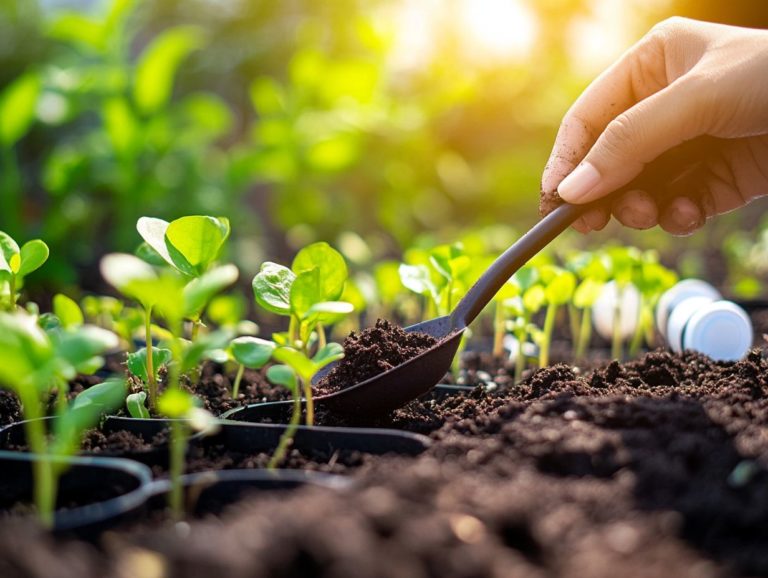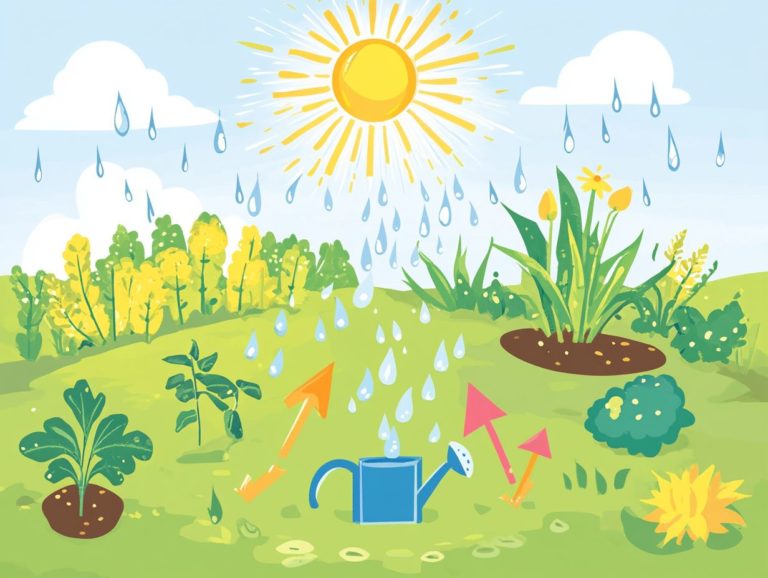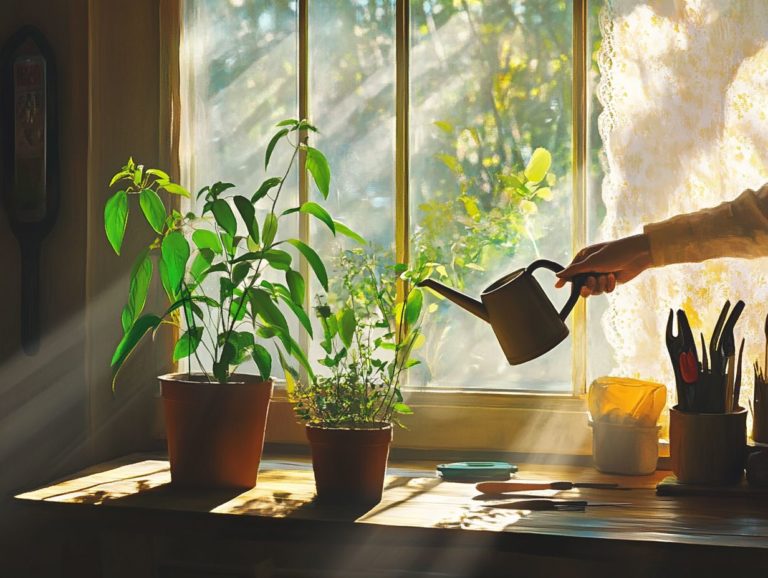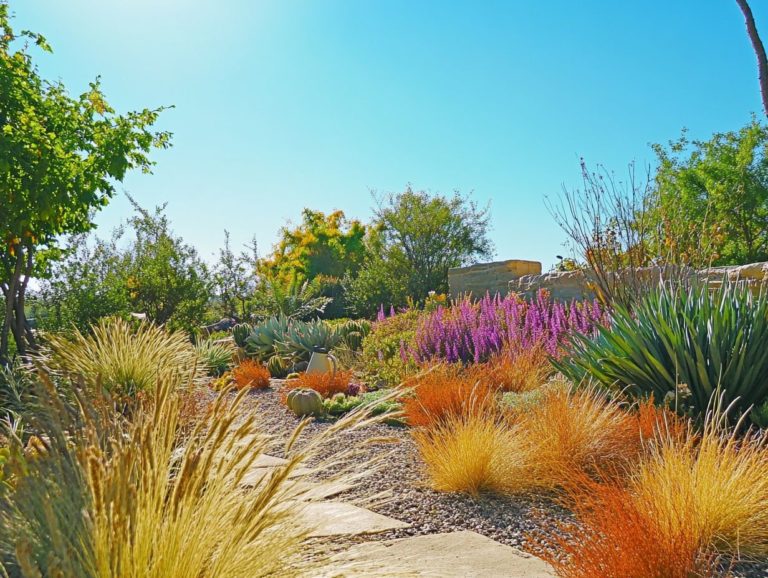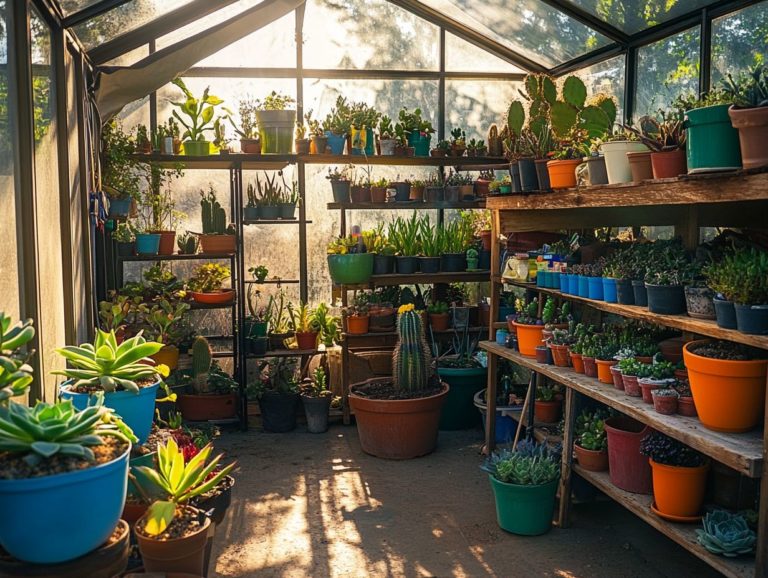Best Practices for Container Gardening
Let s dive into the vibrant world of container gardening! Container gardening presents an accessible and fulfilling opportunity to nurture plants, whether you have a spacious backyard or a cozy balcony.
This guide explores essential best practices to help you cultivate a thriving container garden. From choosing the right containers and soil to ensuring proper drainage and sunlight, it covers all the key elements for your success.
It also highlights common pitfalls to avoid, offers budget-friendly tips, and outlines how to fully enjoy the rewards of your green thumb. Don t wait! Start your container garden today and enjoy the beauty of your plants!
Contents
- Key Takeaways:
- 1. Choose the Right Containers
- 2. Select the Right Soil
- 3. Plant the Right Plants
- 4. Provide Adequate Drainage
- 5. Water Regularly
- 6. Fertilize Appropriately
- 7. Consider Companion Planting
- 8. Protect from Pests and Diseases
- 9. Provide Adequate Sunlight
- 10. Prune and Trim as Needed
- 11. Rotate Plants
- 12. Use Mulch
- 13. Monitor for Overcrowding
- 14. Harvest and Enjoy Your Plants
- 15. Properly Store Containers for Winter
- What Are the Benefits of Container Gardening?
- Frequently Asked Questions
Key Takeaways:
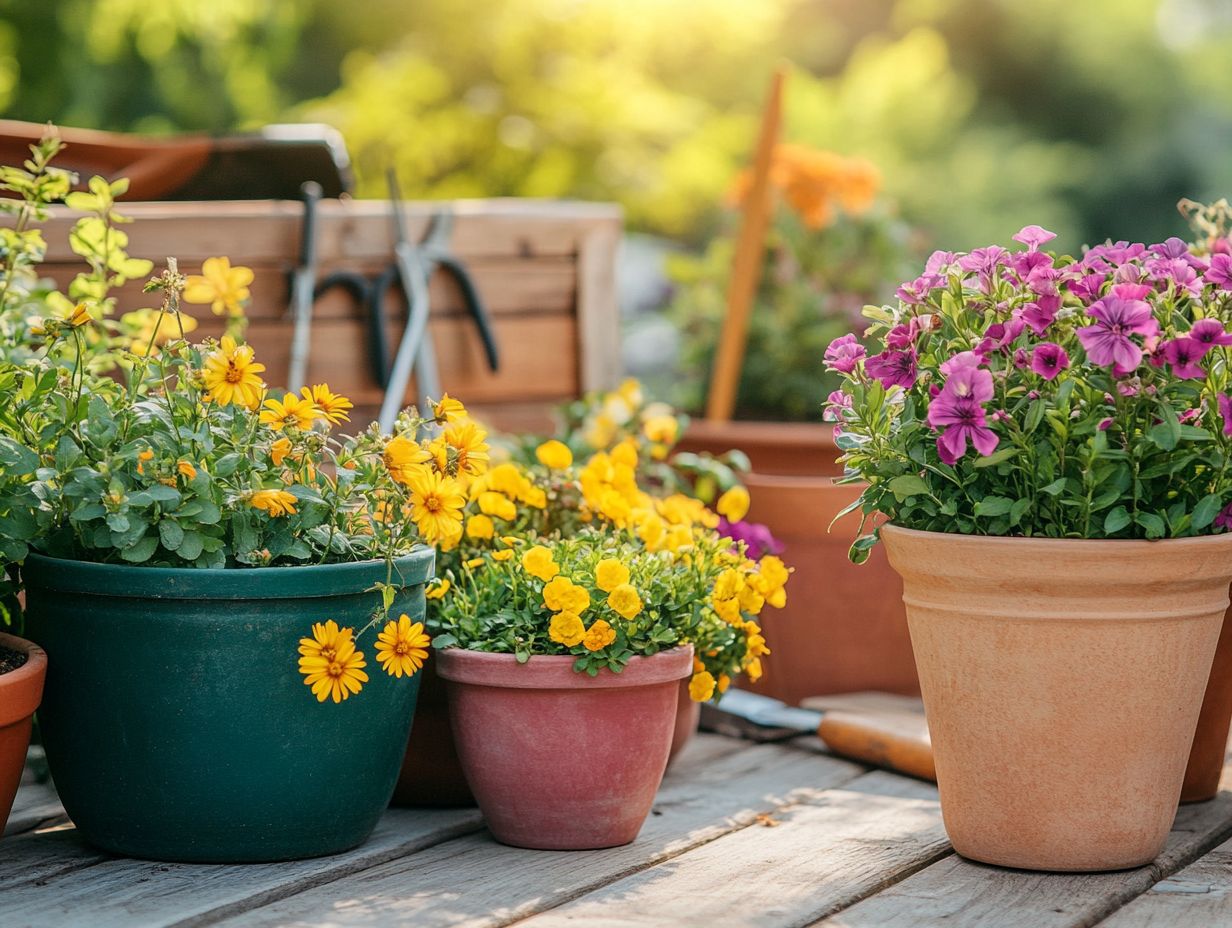
- Choose the right containers for proper growth and drainage.
- Select the right soil to provide necessary nutrients and moisture.
- Plant suitable plants for your container garden, considering their size, sunlight, and water needs.
1. Choose the Right Containers
Choosing the right containers is a crucial first step in your journey toward successful container gardening. Different types, sizes, and materials will significantly influence plant growth and the overall aesthetics of your garden.
The importance of selecting appropriate containers cannot be overstated; plants thrive when their containers cater to their specific needs. For example, terracotta pots allow air circulation to prevent overwatering, while plastic pots retain moisture, making them ideal for water-loving varieties.
Evaluate container depth, as it directly impacts root development. Shallow containers may limit root growth, while deeper ones encourage expansive development. It’s also wise to match your containers to your chosen plants; herbs thrive in smaller pots, while larger perennials need more space to spread their roots.
By carefully considering container materials and sizes, you can create an environment that supports healthy growth and vibrant blooms. Additionally, following the best practices for garden layout in drought can help turn your gardening dreams into a flourishing reality.
2. Select the Right Soil
Selecting the right soil is essential for your container gardening success. Quality potting soil not only provides vital nutrients but also supports healthy root systems and maintains the right amount of moisture.
The ideal potting mix goes beyond nutrition; it needs proper aeration and drainage to prevent root rot and allow air to circulate freely. When choosing potting soil, look for mixes that include organic fertilizers tailored to different plant species. These amendments enhance nutrient availability over time, meeting your plants’ diverse needs as they grow.
By prioritizing aeration and nutrient-rich components, you can significantly contribute to the overall health and maintenance of your container plants, creating a thriving garden environment that flourishes beautifully.
3. Plant the Right Plants
Selecting the right plants is vital for cultivating thriving container gardens. The compatibility of your chosen plant varieties can greatly impact the overall success of your gardening efforts, whether you’re growing herbs, vegetables, or vibrant blooms.
To achieve the best results, consider factors like growing conditions such as temperature, humidity, and soil type, along with each plant’s unique light requirements some thrive in full sun, while others prefer partial shade.
Seasonal gardening is another essential factor; choosing plants that thrive in specific seasons can enhance their growth and flowering potential. For herbs, select varieties with similar watering needs, such as basil and parsley, to simplify care.
Choose flowers that complement each other, like marigolds beside zinnias, to create a visually stunning arrangement while attracting beneficial pollinators, fostering a healthier and more vibrant container garden.
4. Provide Adequate Drainage
Providing adequate drainage is essential in container gardening. Without sufficient drainage holes, you risk root rot and unhealthy plants due to poor water retention and imbalanced soil moisture levels.
As you choose your containers, ensure they feature multiple drainage holes to allow excess water to escape effortlessly. If you want to enhance drainage, consider adding materials like gravel at the bottom of the pot. This creates an effective barrier that prevents soil from clogging those crucial holes.
Selecting specialized potting mixes designed for containers can enhance water flow and aeration, fostering healthy root development. Proper drainage keeps your plants happy and healthy, ensuring vibrant growth!
It not only wards off waterlogging but also promotes vibrant plant growth, resulting in specimens that are stronger, more resilient, and better equipped to absorb the nutrients they need to flourish.
5. Water Regularly
Regular watering is crucial for ensuring your container garden thrives, as it directly impacts soil moisture levels and caters to the specific watering requirements of different plant varieties.
Familiarizing yourself with various watering techniques like using a watering can or a method that delivers water directly to the roots of plants can greatly enhance your plants’ health. A watering can provides precision and allows you to control the water flow, making it especially beneficial for delicate plants.
In contrast, drip irrigation meticulously delivers water right to the root zone, minimizing waste and promoting consistency. To know when to water, it’s essential to monitor soil moisture.
Simply inserting a finger into the soil can help you determine its moisture content. Incorporating practices like mulching helps retain that precious soil moisture, while choosing the right potting mix improves drainage and overall plant vitality. This allows you to optimize your watering schedule.
6. Fertilize Appropriately
Appropriate fertilization is essential in your container gardening journey. By selecting the right organic fertilizer, you ensure that your plants receive the nutrients they need to thrive throughout the growing season.
Choosing the right type of organic fertilizer can truly make a significant difference, particularly when considering the unique needs of various plant species. Options like compost, manure, and worm castings deliver essential nutrients without the harsh chemicals that accompany synthetic alternatives.
Timing your application is equally important; knowing when to fertilize can greatly enhance nutrient uptake and support your plants’ growth cycles. A well-planned schedule and method whether through top dressing, which involves adding fertilizer on top of the soil without mixing it in, or liquid feeds can lead to healthier plants and a more abundant harvest.
This ultimately allows your container garden to flourish to its fullest potential.
7. Consider Companion Planting
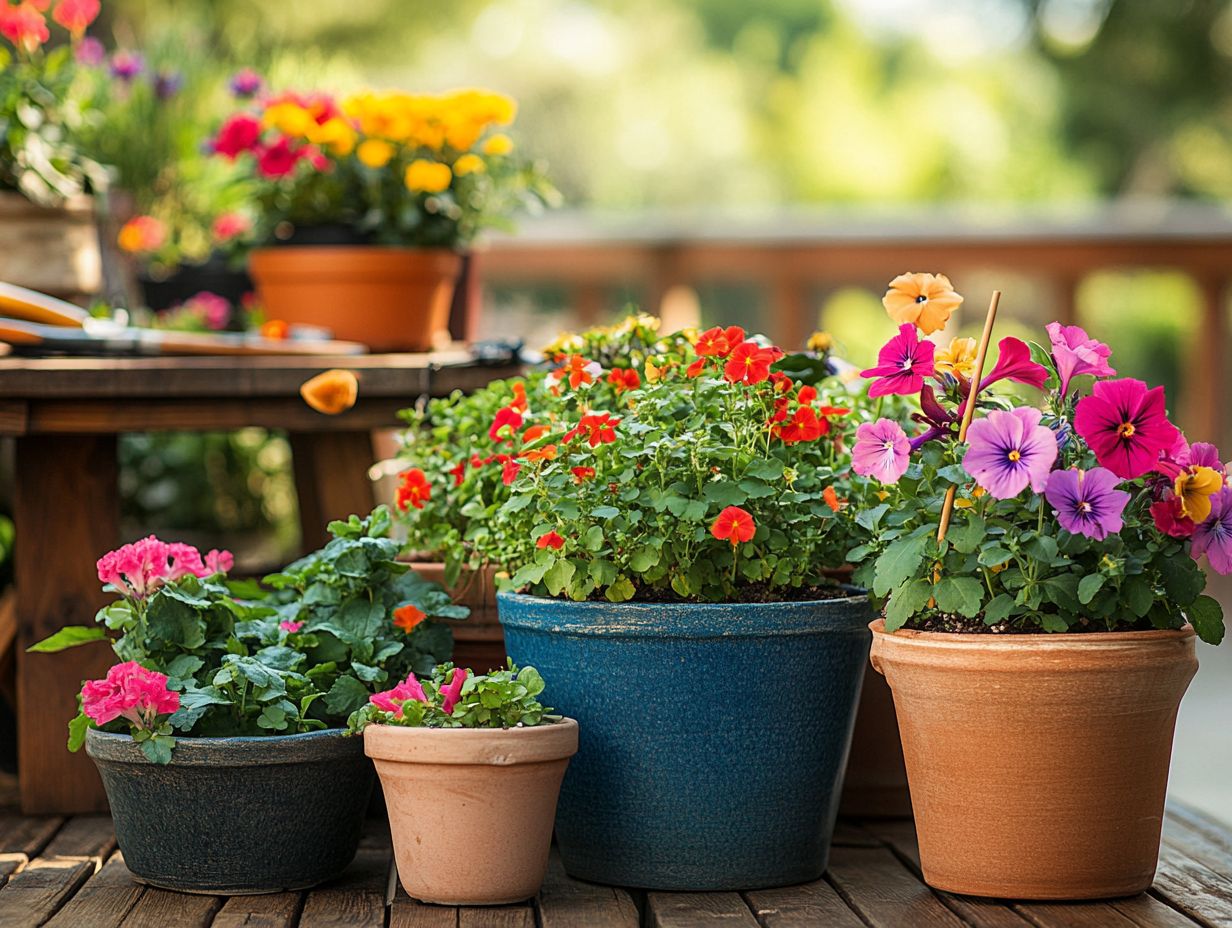
Considering companion planting can significantly elevate your container garden’s success. By understanding the habits of plant neighbors, you can foster a thriving ecosystem and create optimal growing conditions.
When you select complementary plants, you re not just maximizing space; you re also enhancing the overall health of your garden. For instance, pairing marigolds with tomatoes helps repel harmful nematodes, while planting basil alongside peppers can enhance their flavor and deter aphids.
Thoughtfully designing your seasonal planters can yield impressive results. Imagine placing taller plants like sunflowers next to low-growing herbs such as thyme and oregano, ensuring every plant basks in adequate sunlight.
This strategic arrangement leads to better yields and supports vital pollinators, ultimately creating a self-sustaining environment that nurtures organic growth while minimizing the need for chemical interventions.
8. Protect from Pests and Diseases
Protecting your container garden from pests and diseases is crucial for healthy plant growth.
It also preserves the visual appeal of your garden. Stay vigilant against potential threats.
Recognizing early signs of infestations or diseases can make a big difference. Effective pest control includes preventive and reactive strategies.
Maintain impeccable sanitation, rotate your crops, and select disease-resistant varieties. Keep an eye out for unusual discoloration or wilting.
Encourage beneficial insects and practice proper watering techniques. These actions help cultivate a balanced ecosystem that promotes vigorous plant health.
9. Provide Adequate Sunlight
Providing adequate sunlight is vital for your container garden’s success. Different plants have unique light requirements that affect their growth and flowering.
Start by observing how sunlight moves across your plot during the day. Note any obstacles, like trees or buildings, that cast shadows.
Place your containers in optimal locations to enhance growth and encourage vibrant flowering. This creates a stunning burst of color in your garden.
As the seasons change, adjust your containers’ positions. This ensures your plants receive the necessary sunlight during winter and summer.
Regularly monitor and reposition them to boost your garden’s health and productivity!
10. Prune and Trim as Needed
Regular pruning and trimming are essential for maintaining healthy, productive plants. These practices promote bushier growth and prevent overcrowding.
Understanding the specific needs of your plants enhances their vitality and aesthetic appeal. For example, knowing when to trim perennials encourages robust flower production.
This also supports herb growth by rejuvenating older stems. Techniques like pinching back or selective cutting help direct energy into the best parts of the plant.
Incorporate proper watering and fertilization alongside pruning. This transforms your garden into a reflection of your dedicated efforts.
11. Rotate Plants
Rotating plants is a smart strategy for your container garden. It enhances soil health and prevents nutrient depletion while keeping pests and diseases at bay.
By varying your plants each season, you improve the soil’s moisture retention and nutrient content. This approach replenishes essential nutrients and fosters a diverse ecosystem.
Plan your layouts and planting schedules carefully for successful rotation. Follow heavy feeders like tomatoes with nitrogen-fixing legumes to optimize soil fertility.
Incorporating cover crops during the off-season preserves soil structure and moisture. This thoughtful approach leads to healthier plants and a more productive garden!
12. Use Mulch
Using mulch in your container garden offers numerous benefits. It helps retain soil moisture, control weeds, and enhance visual appeal in your gardening space.
You can choose from various types of mulch to suit your needs. For example, organic mulches like shredded bark or straw improve soil structure as they break down and supply essential nutrients to your plants over time. Alternatively, inorganic options such as gravel or plastic help maintain consistent moisture levels while reducing weed growth.
Incorporating mulch into your regular plant care routine creates a protective environment that shields roots from extreme temperatures. This results in healthier plants and potentially higher yields. Thoughtfully using mulch can elevate your gardening experience and ensure your container plants thrive beautifully.
13. Monitor for Overcrowding
Monitoring for overcrowding in your container garden is essential for the health of each plant. When too many plants are crammed into one container, they compete for nutrients and water, which isn’t ideal.
This competition can lead to stunted growth, yellowing leaves, and increased vulnerability to pests and diseases. Plants need room for their roots to spread; when packed too closely together, their performance declines.
To prevent overcrowding, select plants with similar growth habits and sizes. Check your plants regularly to catch any issues early, allowing you to make quick decisions about pruning or repotting.
Using larger containers or grouping plants that complement one another fosters a balanced environment and promotes vigorous growth. This approach also enhances the aesthetic appeal of your garden.
14. Harvest and Enjoy Your Plants
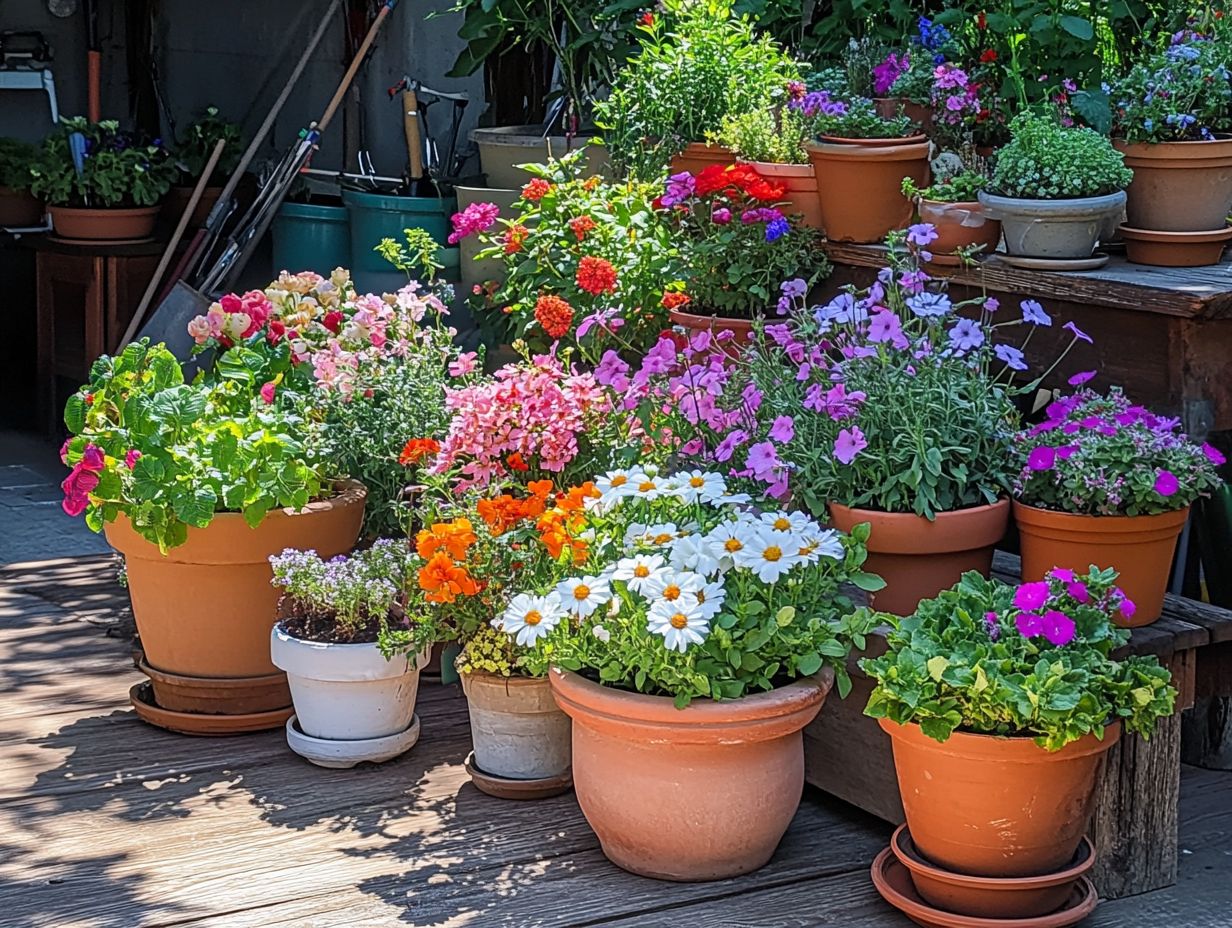
Harvesting your plants is the rewarding culmination of your efforts in container gardening. You get to savor fresh herbs, vegetables, and flowers directly from your own garden.
The timing of your harvest is crucial for maximizing flavor and nutritional content. Pay attention to specific growing cycles. For example, harvesting herbs like basil just before they flower secures the most aromatic leaves.
Using sharp, clean tools for cutting promotes healthier plants and supports future growth and harvests.
Incorporating home-grown elements into your culinary creations elevates taste and provides unique satisfaction, knowing that you nurtured them yourself. This transforms your journey from planting to plate into something truly special.
15. Properly Store Containers for Winter
Properly storing your containers for winter is vital in container gardening. It protects your gardening investment and ensures that your pots remain in excellent condition for the next growing season.
As temperatures drop, assess the material and size of each container. Not all containers withstand winter’s chill well. For example, clay pots can crack in freezing temperatures, so empty them and store them in a frost-free environment. In contrast, durable plastic and metal containers are usually more resilient, but ensure they are clean and dry before storing.
Evaluate which plants need to be transitioned indoors. Tropical plants that struggle in colder climates often thrive when relocated. Group tender plants together to simplify the move, while hardier species can stay outside if protected with mulch or burlap wraps.
Start incorporating these tips today for a thriving garden!
What Are the Benefits of Container Gardening?
Container gardening offers many benefits, making it perfect for beginners and experienced gardeners alike, particularly in urban environments where space is limited.
This method provides remarkable flexibility, allowing you to nurture plants in compact areas like balconies, patios, or even window sills. Accessibility is a significant advantage; if you face mobility challenges, you can care for your plants without bending down or exerting yourself too much.
By creating microclimates (small areas with different climates than the surrounding area) within your containers, you can tailor conditions to suit various plant species. To maximize these benefits, choose the right soil mix and position your containers strategically whether in sunlit spots or shaded areas to boost plant growth dramatically.
Regularly rotating and mixing your plants fosters a vibrant garden ecosystem, making container gardening practical and fulfilling.
What Are the Best Plants for Container Gardening?
Identifying the best plants for your container garden is vital for success. Some plants adapt better to life in containers than others.
Take herbs like basil and thyme; they are excellent choices for container gardening because they need minimal space and thrive in full sun, enjoying about six to eight hours of light each day. Their compact growth makes them ideal for small pots or window boxes.
Cherry tomatoes are another favorite among container gardeners, boasting an upright growth habit and impressive yields. They thrive in well-drained soil and love sunlight, making them a rewarding choice for your setup.
Don t forget vibrant flowers like marigolds and petunias. These not only enhance the aesthetic appeal of your arrangements but also thrive in sunny spots, adding splashes of color throughout the growing season.
To ensure these varieties reach their full potential, remember that proper watering and occasional fertilization are key.
How Can One Maximize Space in a Container Garden?
Maximizing space in your container garden is essential for cultivating various plants, especially in cozy spots like balconies and small yards.
By using techniques like vertical gardening (growing plants upward using supports) and tiered planting, you can create a lush environment even when space is tight. Vertical gardening employs structures like trellises that allow your plants to climb, saving valuable horizontal space. Meanwhile, tiered planting arrangements let you layer containers, optimizing sunlight exposure and ensuring good air circulation.
Choosing the right container sizes that match the growth habits of your plants is also crucial. Understanding each plant’s growth behavior prevents resource competition and helps create a flourishing container garden that feels expansive and vibrant.
What Are Some Common Mistakes in Container Gardening?
Knowing common mistakes in container gardening can significantly enhance your gardening success and ensure your plants thrive, especially when you implement best practices for maintaining garden soil health.
Focus on the basics to avoid issues like improper watering techniques, which can lead to root rot or drought stress. Make sure to follow the best practices for watering drought plants and ensure each container has drainage holes! This simple step prevents water from pooling and keeps your plants healthy. Overcrowding your plants restricts their growth and causes competition for nutrients and light.
To promote healthy growth, choose pots that provide ample space for each plant and establish proper watering schedules that cater to the unique needs of different species. Following the best practices for urban drought gardening will transform your container garden into a flourishing oasis.
Start your container garden today and enjoy fresh herbs and vibrant flowers right at home!
How Can You Create a Vibrant Container Garden on a Budget?
You can easily create a vibrant container garden on a budget, thanks to a touch of creativity and resourcefulness. This way, you can enjoy the joys of gardening without breaking the bank.
Explore various cost-effective strategies to maximize your gardening experience. Start with repurposed materials like old buckets, tins, or wooden crates. This not only cuts costs but also gives your garden a unique character. Choose affordable plant varieties, such as herbs and local flowers, to enjoy excellent yields without hefty price tags.
Craft homemade organic fertilizers from kitchen scraps to promote healthier plant growth without spending much. You can find containers at thrift stores or online marketplaces, which not only saves you money but also creates a nurturing environment for your plants.
Frequently Asked Questions
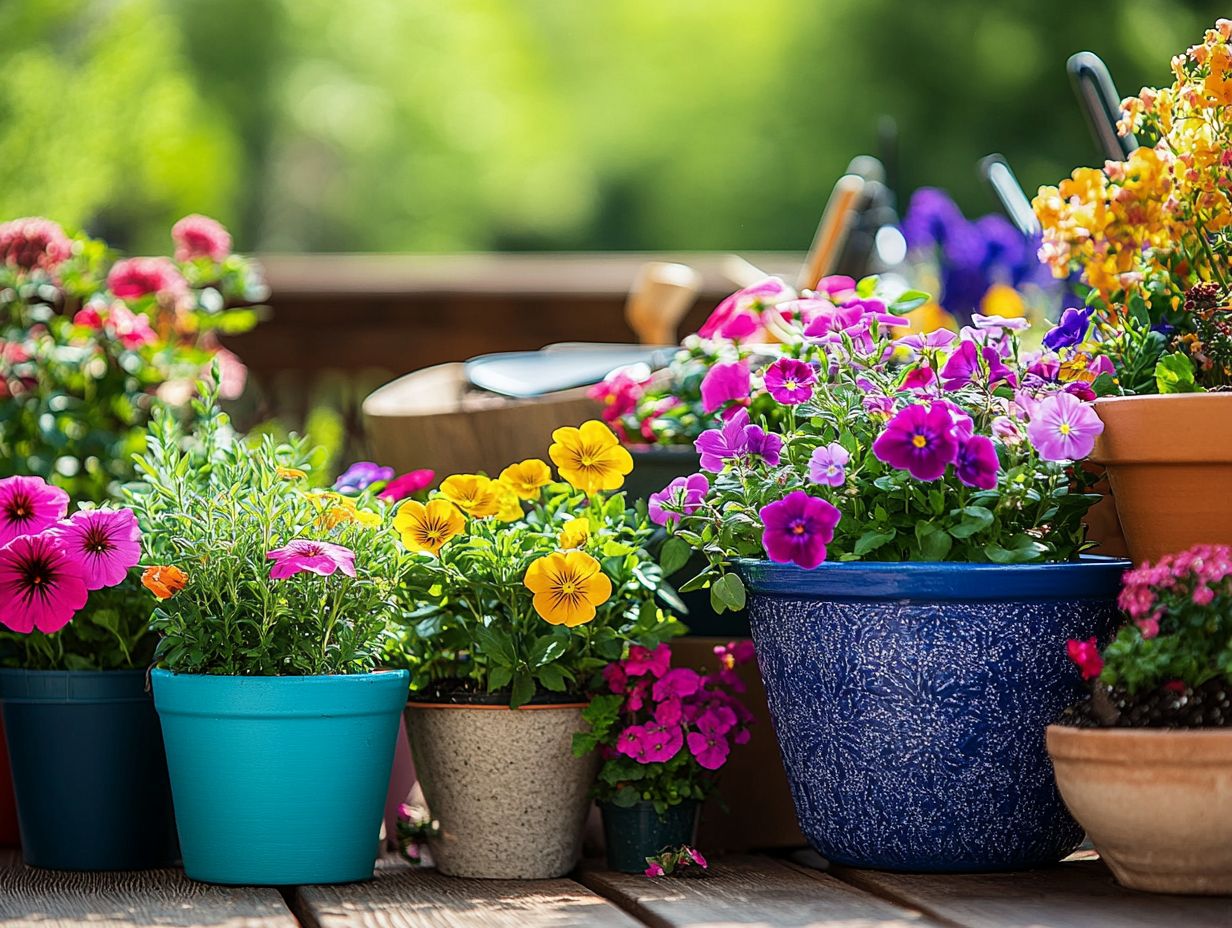
What are the best practices for container gardening?
Best practices for container gardening include:
- Choosing the right containers.
- Using quality soil, like potting soil.
- Providing proper drainage.
- Selecting suitable plants.
- Maintaining regular care and maintenance.
What should I look for in a container?
The right containers should be large enough to accommodate the root systems of your plants, have proper drainage holes, and be made of durable materials such as plastic, ceramic, or wood.
What type of soil should I use for container gardening?
It is best to use a high-quality potting mix or a blend of potting soil, perlite, and compost for container gardening. Avoid garden soil, as it can become compacted and hinder plant growth.
Do I need to provide drainage for my container garden?
Yes, proper drainage is crucial. Ensure your containers have drainage holes and use a layer of gravel or broken pottery pieces at the bottom to prevent water from pooling.
What are some suitable plants for container gardening?
Many plants thrive in containers, including herbs, vegetables, flowers, and even small trees. Consider the size and sunlight requirements of your plants when selecting them for your container garden.
How often should I water my container garden?
The frequency of watering depends on factors like the type of plants, soil, and climate. A good rule of thumb is to water when the top inch of soil is dry, but regularly check the soil’s moisture level.
Ready to start your container garden today? Embrace the fun and creativity of gardening without overspending!

